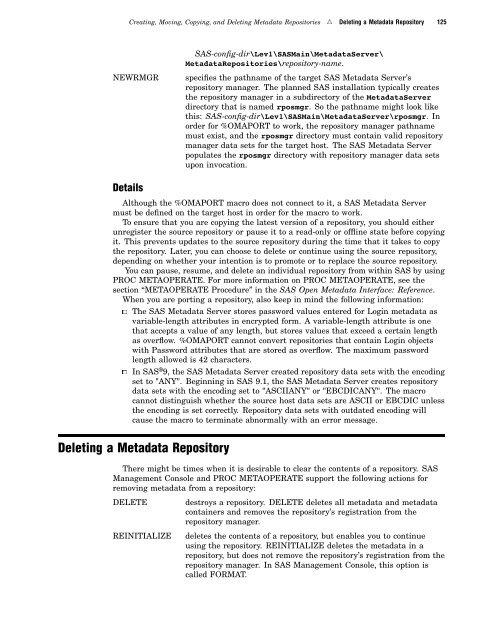SAS 9.1.3 Intelligence Platform: System Administration Guide
SAS 9.1.3 Intelligence Platform: System Administration Guide
SAS 9.1.3 Intelligence Platform: System Administration Guide
You also want an ePaper? Increase the reach of your titles
YUMPU automatically turns print PDFs into web optimized ePapers that Google loves.
Creating, Moving, Copying, and Deleting Metadata Repositories R Deleting a Metadata Repository 125<br />
<strong>SAS</strong>-config-dir\Lev1\<strong>SAS</strong>Main\MetadataServer\<br />
MetadataRepositories\repository-name.<br />
NEWRMGR specifies the pathname of the target <strong>SAS</strong> Metadata Server’s<br />
repository manager. The planned <strong>SAS</strong> installation typically creates<br />
the repository manager in a subdirectory of the MetadataServer<br />
directory that is named rposmgr. So the pathname might look like<br />
this: <strong>SAS</strong>-config-dir\Lev1\<strong>SAS</strong>Main\MetadataServer\rposmgr. In<br />
order for %OMAPORT to work, the repository manager pathname<br />
must exist, and the rposmgr directory must contain valid repository<br />
manager data sets for the target host. The <strong>SAS</strong> Metadata Server<br />
populates the rposmgr directory with repository manager data sets<br />
upon invocation.<br />
Details<br />
Although the %OMAPORT macro does not connect to it, a <strong>SAS</strong> Metadata Server<br />
must be defined on the target host in order for the macro to work.<br />
To ensure that you are copying the latest version of a repository, you should either<br />
unregister the source repository or pause it to a read-only or offline state before copying<br />
it. This prevents updates to the source repository during the time that it takes to copy<br />
the repository. Later, you can choose to delete or continue using the source repository,<br />
depending on whether your intention is to promote or to replace the source repository.<br />
You can pause, resume, and delete an individual repository from within <strong>SAS</strong> by using<br />
PROC METAOPERATE. For more information on PROC METAOPERATE, see the<br />
section “METAOPERATE Procedure” in the <strong>SAS</strong> Open Metadata Interface: Reference.<br />
When you are porting a repository, also keep in mind the following information:<br />
3 The <strong>SAS</strong> Metadata Server stores password values entered for Login metadata as<br />
variable-length attributes in encrypted form. A variable-length attribute is one<br />
that accepts a value of any length, but stores values that exceed a certain length<br />
as overflow. %OMAPORT cannot convert repositories that contain Login objects<br />
with Password attributes that are stored as overflow. The maximum password<br />
length allowed is 42 characters.<br />
3 In <strong>SAS</strong> ® 9, the <strong>SAS</strong> Metadata Server created repository data sets with the encoding<br />
set to "ANY". Beginning in <strong>SAS</strong> 9.1, the <strong>SAS</strong> Metadata Server creates repository<br />
data sets with the encoding set to "ASCIIANY" or "EBCDICANY". The macro<br />
cannot distinguish whether the source host data sets are ASCII or EBCDIC unless<br />
the encoding is set correctly. Repository data sets with outdated encoding will<br />
cause the macro to terminate abnormally with an error message.<br />
Deleting a Metadata Repository<br />
There might be times when it is desirable to clear the contents of a repository. <strong>SAS</strong><br />
Management Console and PROC METAOPERATE support the following actions for<br />
removing metadata from a repository:<br />
DELETE destroys a repository. DELETE deletes all metadata and metadata<br />
containers and removes the repository’s registration from the<br />
repository manager.<br />
REINITIALIZE deletes the contents of a repository, but enables you to continue<br />
using the repository. REINITIALIZE deletes the metadata in a<br />
repository, but does not remove the repository’s registration from the<br />
repository manager. In <strong>SAS</strong> Management Console, this option is<br />
called FORMAT.
















